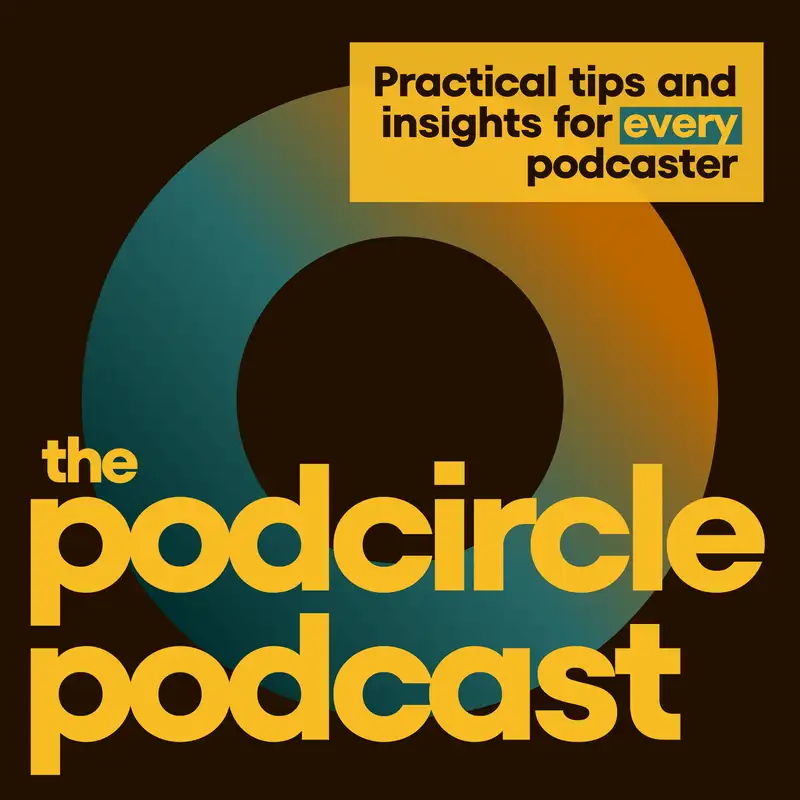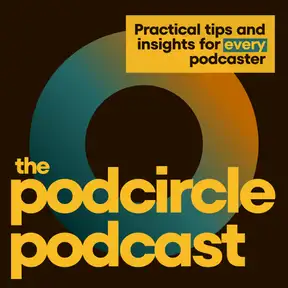34. Identifying & Engaging Your Ideal Podcast Audience
There's a difference between your target market and your target audience. The target market is a bit larger. You may still appeal to them, but the more specific you get with who you're talking to, the better you can create content that connects with the people that you want to attract the most.
Kyle Cummings:Welcome to the Podcircle Podcast where we bring practical tips and insights for every podcaster.
Mickenzie Vought:Whether you're just getting started or you're already a seasoned podcast pro, these conversations dive into the topics that matter most to you. Thanks for joining us for another episode today, friends. We are so excited to be jumping in and expounding a little bit more on something that I briefly mentioned on episode 32, 5 questions you need to ask about your podcast. We are gonna be talking all about your ideal audience today, and we're gonna help you get super clear about who you're talking to. As a reminder, if you're listening on YouTube, we would love for you to subscribe, follow along, catch up on all episodes, and join the conversation.
Kyle Cummings:And if you're listening on Apple Podcasts or Spotify, I would really appreciate if you'd take a few moments just to leave us a 5 star rating and a quick review. It really helps out the show.
Mickenzie Vought:Alright. So let's jump in. What is your target audience? I feel like this word kinda gets thrown around a little bit. But a target audience or sometimes called an ideal customer is a group of customers that you want to target with your podcast.
Mickenzie Vought:You wanna build trust with them and eventually generate revenue and sales for your products or services. It should accurately represent your listeners who are more likely to buy your specific product or service. So here's some examples. If you're a nutritionist or a wellness coach, an example of a target audience for you could be working moms between the ages of 2542, interested in healthy food with a monthly income of $4,000. There's a difference between your target market and your target audience.
Mickenzie Vought:The target market is a bit larger. You may still appeal to them, but the more specific you get with who you're talking to, the better you can create content that connects with the people that you want to attract the most. Here's a Podcircle example. Our target audience is business owners who want to launch and sustain podcasts that support their products and services interested in optimizing their time and resources through efficient marketing. Our target market might just be people who wanna launch and sustain podcasts, but we've made that distinction.
Mickenzie Vought:And the more specific we can get around the business angle and wanting to appeal to business owners, the more successful we're gonna be.
Kyle Cummings:So you're gonna wanna start with what you know, just on a simple basic level. Start with what you know. The The first step in identifying your target audience is to look at your current client base. Rather than start from 0, just start with what you know. So if you're in the early stages of your business, use it as a baseline.
Kyle Cummings:Find any commonalities that you can identify across your current customers. You're not trying to reinvent the wheel or anything, but just notice, like, are there any themes? Like, do I have the most of my customers? Are they in the nonprofit space? Are they in the business space?
Kyle Cummings:Try to find those common threads there. And if you don't have a current client base, start with what you know about what you specifically, what you bring to the table. Who do you want to appeal to?
Mickenzie Vought:That's good.
Kyle Cummings:And a side note here is you'll be way more successful when you enjoy who you're working with. Mhmm. Finally, gather basic demographics. So take some time to look at the gender, age bracket, industry, location, and income level of your ideal kind of target market.
Mickenzie Vought:And a good place to start for that type of information is to go to your social followings and your analytics. They give you a ton of things, and that'll just give you a quick glimpse of a portion of your audience. If they're already following you on Instagram, it might give you a good baseline. So the second thing that we're gonna encourage you to do to identify this ideal customer is to connect with their habits. This is really the fun part, I think.
Mickenzie Vought:Dig a little deeper and consider beyond just those demographics now that you've identified them and really turn to their habits and preferences. So where do they listen to podcasts? Are they Spotify listeners or Apple? Where do they find their podcast? Is it a word-of-mouth thing?
Mickenzie Vought:Do they talk a lot about it? Do they find you on Google? Do they find you from other podcasts? Maybe that'll change the way that you maybe bring on other podcasters or, you know, collaborate with them. Where do they buy their products and services?
Mickenzie Vought:Are they really Google users? Are they Pinterest users? Do they go on Instagram or Target or etcetera? And then what kind of device do they use to listen? I think this is an interesting one.
Mickenzie Vought:Are they Apple or are they Google? Depending on your product, it may be helpful how often and then how long? So is it they're listening on a short commute? They're how often and then how long? So is it they're listening on a short commute?
Mickenzie Vought:They're listening while they're doing the dishes and their children are running around? Just thinking through those things as well. And the last thing is where are they hanging out for their social? So if you want to use your podcast, and we encourage you, to optimize your marketing strategy and create efficient marketing assets, which we think you can do from your podcast, you need to know where those need to be optimized to be post. For example, we've made a pivot to being more strategic on LinkedIn.
Mickenzie Vought:I know you, Kyle, have been really strategic in creating an individual presence on LinkedIn that then harkens back to Podcircle and you're using our assets in a different way than you used to because you wanna show your face. And every week, we show up in a podcast, so why not use those assets to show your face and humanize your brand and build your online presence a little bit?
Kyle Cummings:Yeah. That's why we call it efficient marketing. It's we get so much out of these short 10 to 15 minute episodes and we can literally just spray all over the Internet. Right. You know?
Kyle Cummings:And and that that sounds really haphazard. We obviously do it in a really strategic way, but it's easier to be strategic about it when when you've kinda done it strategically from you know, in terms of, like, what what we're talking about in the podcast and then pulling those really great clips and just using them strategically between my personal channel, on LinkedIn and then using a different set of them even just on our our more outward facing, like, Podcircle accounts across social media and things like that. So the next thing we're gonna talk about is to identify your customer's goals. Mhmm. So instead of just asking what do they want, go a little bit deeper than just the typical surface level questions.
Kyle Cummings:So just like we encourage you to get specific with your goals of your actual podcast, get specific about the goals of your consumer, and what do they want to achieve. Knowing the end goal of what your consumer wants will help you to connect on a deeper level with them and to build trust. And as we talk about often on here, we buy from people that we know, like, and trust. And that trust factor is so huge and is so much of why we believe in podcasting because podcasting is a way to build trust and nurture that relationship.
Mickenzie Vought:Yeah.
Kyle Cummings:So for instance, if you are a dog food company whose ideal customer is, let's just say, upper middle class men who are into adventuring with their pets and like camping. Their goals might be to find a dog food that fuels their dog for long hikes and, you know, provides bone and joint support for them. That's just one example. We knew at PodCircle that our audience's goals are to build trust with their audiences, to generate revenue, and often to build their online presence through efficient marketing. And at PodCircle specifically, we get really clear on those goals in our first meetings with podcasters, so that we can provide great service to them and, services that are gonna help them reach their goals.
Kyle Cummings:It also informs the kind of content that we produce for them, I e, you know, if we're helping them figure out their content for the next month Yep. We're gonna do that very strategically to meet their their goals. Also, the clips that we pull for their social media from the podcast are gonna be very specific based on whatever their goals are. So you're gonna hear it a lot from us. Strategy. Strategy. Strategy.
Mickenzie Vought:Yeah. And then once we know those goals, that actually informs the conversations you and I have. Right? We can hearken back to, oh, our customer is telling us what their goals are. How do we create content that's gonna help and serve them?
Mickenzie Vought:So the 4th way that we wanna help you identify your target audience is to outline their problems and fears. People make decisions and purchases based on 2 things. One, a desire that they want fulfilled or a problem they need solved. Your greatest connection and content, as I stated in the last episode, comes from the intersection of your audience's problems and your expertise. So it's kinda like a little Venn diagram.
Mickenzie Vought:So I would encourage you to make a list of those problems and fears that you know your customer has, then outline the ones that your product, service, or even your expertise can offer solutions. So it could be the answer you have for them is a knowledge thing. And you can share in your podcast the knowledge you have around something. You can give the ingredients without giving the recipe that will just help agitate and service a problem that they have. Even if you're not selling them the solution, your podcast can still solve their problems and build trust.
Mickenzie Vought:So for an example, if you're a florist, the end goal is that you want to do a bride's flowers. But the problems that she might have that you could help her and demonstrate your subject matter expert around might be how to budget for flowers, what's the right aesthetic for a wedding, how do you, determine what flowers to do for bridesmaids dresses, flowers that last in the heat. You know, those are some content things, but those are also the problems and fears they have. And so help identify what are their problems, what are their fears, and how can I show up better for them? So once we have a general idea of who this ideal customer is, we're gonna do the last thing.
Mickenzie Vought:Kyle, tell us what are we gonna do.
Kyle Cummings:We're gonna respond to feedback. Yes. And this is an iterative process So respond to the verbal feedback given to you when you talk to customers. Mhmm. So let's set their feedback in surveys, talk to customers in sales calls, etcetera.
Kyle Cummings:So respond to the feedback they give you in their behavior. Are they losing interest? Are they changing their mind? That kind of stuff. And don't be afraid to ask your customers, hey.
Kyle Cummings:What do you want? Mhmm. What are you looking for? That's maybe one of the best things you can do.
Mickenzie Vought:Yeah. And then don't be afraid to shift and get clearer about who your person is, who you are, and aren't talking to. I think that's something that we've done over the last season of just being really strategic of who are we talking to, who do we want to talk to, and kind of, pivoting our strategy. So as a reminder, when you try to serve everyone, you'll probably end up serving no one. Get specific about who you are talking to.
Kyle Cummings:Yep. And it can be hard to do.
Mickenzie Vought:Yep. Totally.
Kyle Cummings:And that's why we're here to help here at Podcircle. If you need help identifying your target audience, you may need an outside voice to help you narrow your focus, get clear on your goals, and create a plan of action that leads to the success that you're after. As part of our launch packages, Mackenzie and I do strategy sessions with podcasters to help them get the clarity that they need to succeed in their show. Mhmm. We also offer these 1 or 2 hour strategy sessions to existing podcasters to help them reenvision and reinvigorate their podcast.
Kyle Cummings:And it doesn't matter if you're starting out or if you've been at it for a while and you're just feeling stuck, struggling to know how to move forward, especially on a strategic level, we're here to help.
Mickenzie Vought:Definitely. We, would love to come alongside you in your podcast journey. And make sure that you're subscribed wherever you listen to podcasts so you don't miss a single episode. And if you're on YouTube, we are taking our own advice as our target audience on YouTube. What do you want to see more of from us at the Podcircle Podcast?
Mickenzie Vought:Leave us a comment and we will join in the conversation with you. Alright, friends. We'll see you next week for another episode.
Creators and Guests




